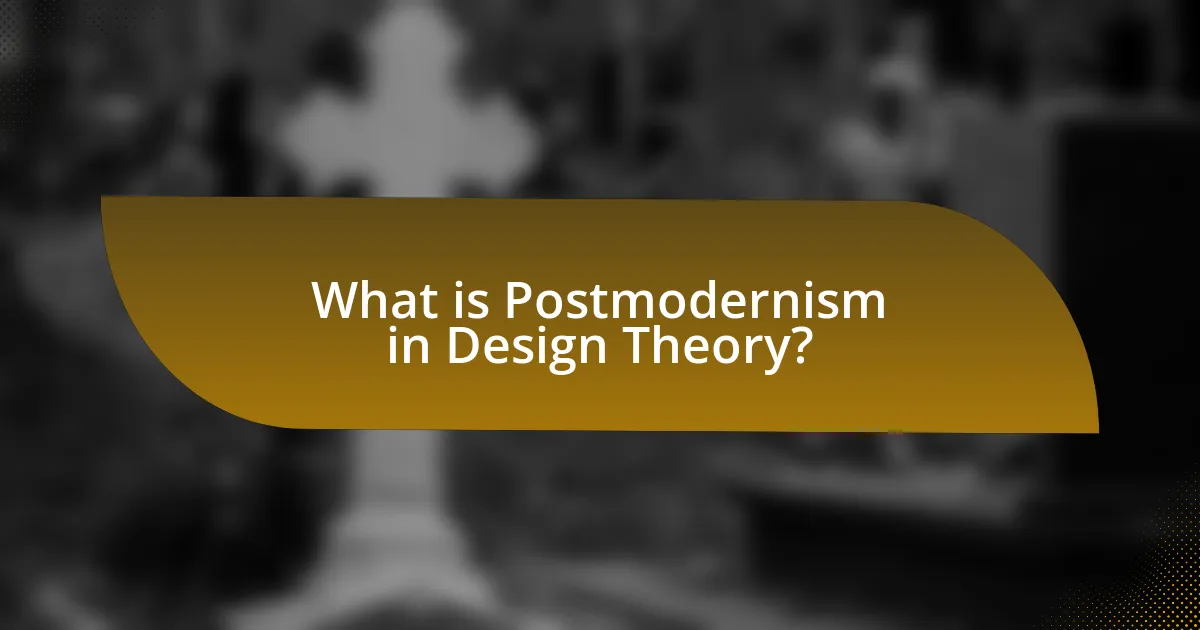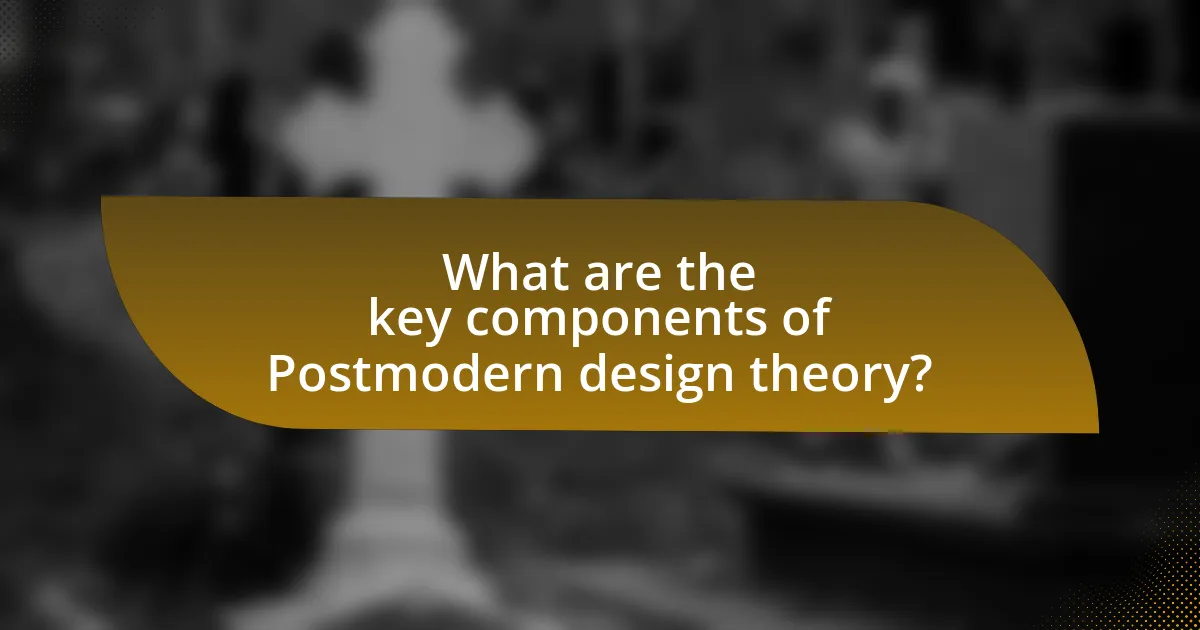Postmodernism in design theory represents a significant shift from modernist principles, emphasizing eclecticism, irony, and a questioning of established norms. This article critically analyzes the key characteristics of postmodern design, including its historical influences, the importance of context, and the role of technology. It also explores critiques of postmodernism, its implications for contemporary design practices, and how it addresses issues of identity and representation. Furthermore, the article examines future directions for postmodern design, highlighting emerging trends such as sustainability and inclusivity, while providing best practices for designers to effectively engage with postmodern principles.

What is Postmodernism in Design Theory?
Postmodernism in design theory is an approach that emerged in the late 20th century, characterized by a departure from the principles of modernism, emphasizing eclecticism, irony, and a questioning of established norms. This design philosophy embraces a mix of styles, historical references, and cultural contexts, often rejecting the idea of a single narrative or universal truth in favor of multiple perspectives. Notably, postmodern design often incorporates playful elements and pastiche, as seen in the works of designers like Michael Graves and Robert Venturi, who challenged the functionalist ideals of modernism by introducing ornamentation and historical references into their designs.
How does Postmodernism differ from Modernism in design?
Postmodernism differs from Modernism in design primarily through its embrace of eclecticism and irony, contrasting with Modernism’s focus on simplicity and functionality. Modernist design, which emerged in the early 20th century, emphasizes minimalism, clean lines, and the idea that form follows function, as seen in the works of designers like Le Corbusier and Mies van der Rohe. In contrast, Postmodernism, which gained prominence in the late 20th century, celebrates diversity, historical references, and playful aesthetics, exemplified by designers such as Michael Graves and Robert Venturi. This shift reflects a broader cultural move away from the rigid ideologies of Modernism towards a more pluralistic and subjective approach in design.
What are the key characteristics of Postmodern design?
Postmodern design is characterized by its eclecticism, irony, and rejection of the modernist principles of simplicity and functionality. This design movement embraces a mix of styles, historical references, and playful elements, often incorporating bold colors and unconventional materials. The use of pastiche, where different styles and cultural references are combined, is a hallmark of postmodern design, as seen in works by architects like Michael Graves and Robert Venturi. Additionally, postmodern design often challenges traditional notions of aesthetics and meaning, promoting a sense of ambiguity and complexity in visual communication.
Why is context important in Postmodern design?
Context is important in Postmodern design because it shapes the interpretation and meaning of design elements within specific cultural, historical, and social frameworks. Postmodern design often challenges traditional aesthetics and embraces eclecticism, making the surrounding context crucial for understanding the intent and significance of a design. For instance, the use of irony and pastiche in Postmodern architecture, such as the Portland Building by Michael Graves, reflects a response to the modernist movement and engages with the urban environment, highlighting the importance of context in conveying messages and evoking reactions from the audience.
What are the historical influences on Postmodern design theory?
Postmodern design theory is historically influenced by several key movements, including Modernism, Deconstruction, and Pop Art. Modernism, which emphasized functionality and simplicity, laid the groundwork for Postmodernism by challenging traditional aesthetics and promoting innovation in design. Deconstruction, particularly in the 1970s, introduced a critical approach to texts and structures, encouraging designers to question established norms and embrace ambiguity. Pop Art, emerging in the 1960s, celebrated consumer culture and mass media, influencing Postmodern design’s playful and eclectic style. These movements collectively shaped Postmodern design by fostering a rejection of uniformity and embracing diversity, irony, and historical reference.
How did cultural shifts impact Postmodern design?
Cultural shifts significantly influenced Postmodern design by promoting diversity, irony, and a departure from modernist principles. The rise of consumerism in the late 20th century encouraged designers to embrace eclectic styles and historical references, leading to a mix of different aesthetics. For instance, the rejection of the “form follows function” mantra allowed for playful and decorative elements in design, as seen in the works of designers like Michael Graves and Philippe Starck. Additionally, the increasing awareness of social issues and identity politics prompted designers to explore themes of gender, race, and cultural identity, resulting in more inclusive and varied design narratives. This shift is evident in the incorporation of non-Western influences and the celebration of marginalized voices within the design community, reflecting broader societal changes.
What role did technology play in the evolution of Postmodern design?
Technology significantly influenced the evolution of Postmodern design by enabling new forms of expression and challenging traditional design principles. The advent of digital tools and software in the late 20th century allowed designers to experiment with complex forms, vibrant colors, and unconventional materials, which became hallmarks of Postmodern aesthetics. For instance, the use of computer-aided design (CAD) software facilitated intricate designs that were previously difficult to achieve, exemplified by architects like Frank Gehry, whose work, such as the Guggenheim Museum in Bilbao, showcases the capabilities of technology in creating non-linear, dynamic structures. Additionally, the rise of the internet and digital media transformed how design was disseminated and critiqued, fostering a more pluralistic approach to design that embraced irony and pastiche, key characteristics of Postmodernism.
What critiques have been made against Postmodernism in design?
Critiques against Postmodernism in design primarily focus on its perceived lack of coherence and depth. Critics argue that Postmodern design often prioritizes superficial aesthetics over functional and meaningful solutions, leading to a sense of disconnection from the user experience. Additionally, the eclectic mix of styles can result in a lack of identity and purpose, as seen in the works of architects like Michael Graves, where ornamentation is criticized for overshadowing structural integrity. Furthermore, Postmodernism has been accused of fostering a culture of irony and pastiche, which some believe undermines the seriousness of design as a discipline. This critique is supported by theorists such as Robert Venturi, who, while influential in Postmodern thought, acknowledged the tension between complexity and simplicity in design, suggesting that the movement often fails to resolve these contradictions effectively.
Why do some critics argue that Postmodernism lacks coherence?
Some critics argue that Postmodernism lacks coherence due to its emphasis on fragmentation and relativism, which undermines the possibility of a unified narrative or meaning. This perspective is supported by the observation that Postmodernist works often reject grand narratives and objective truths, leading to a disjointed and chaotic representation of reality. For instance, Jean-François Lyotard’s concept of the “incredulity towards metanarratives” highlights the skepticism towards overarching explanations, further contributing to the perception of incoherence within Postmodernism.
How have these critiques shaped contemporary design practices?
Critiques of postmodernism have significantly influenced contemporary design practices by promoting a more inclusive and critical approach to design. These critiques emphasize the importance of context, cultural sensitivity, and user-centered design, leading to practices that prioritize social responsibility and sustainability. For instance, the rise of participatory design methods reflects a shift towards involving users in the design process, ensuring that diverse perspectives are considered. Additionally, the critique of superficial aesthetics has encouraged designers to focus on functionality and meaningful engagement with users, as seen in the increasing popularity of designs that address real-world issues such as accessibility and environmental impact. This evolution in design practices is evident in movements like sustainable design and social design, which directly respond to the critiques of postmodernism by advocating for designs that are not only visually appealing but also ethically and socially responsible.
How can we connect Postmodernism to current design trends?
Postmodernism can be connected to current design trends through its emphasis on eclecticism, irony, and the rejection of singular narratives. Current design trends often embrace a mix of styles, materials, and cultural references, reflecting the postmodern idea that meaning is constructed through diverse perspectives. For example, the rise of maximalism in interior design showcases bold colors and patterns, which aligns with postmodernism’s challenge to minimalism and uniformity. Additionally, the use of retro and vintage elements in contemporary fashion and graphic design echoes postmodernism’s playful appropriation of past styles, demonstrating how these principles continue to influence and shape modern aesthetics.
What are the implications of Postmodernism for future design theories?
Postmodernism significantly influences future design theories by promoting pluralism, fragmentation, and the questioning of established norms. This shift encourages designers to embrace diverse perspectives and styles, leading to innovative and non-linear approaches in design. For instance, the rejection of a single narrative allows for the integration of various cultural elements, resulting in designs that reflect a broader range of human experiences. Additionally, postmodernism’s emphasis on irony and playfulness can inspire designers to create more engaging and interactive user experiences. As a result, future design theories are likely to prioritize adaptability and inclusivity, reflecting the complexities of contemporary society.

What are the key components of Postmodern design theory?
The key components of Postmodern design theory include eclecticism, irony, and a focus on context. Eclecticism refers to the blending of different styles and influences, allowing for a diverse range of aesthetics. Irony is often employed to challenge traditional norms and conventions, creating a playful or critical commentary on design. Additionally, Postmodern design emphasizes the importance of context, recognizing that meaning is derived from the cultural and social environment in which a design exists. These components reflect a departure from the modernist ideals of simplicity and functionality, showcasing a more complex and layered approach to design.
How do aesthetics play a role in Postmodern design?
Aesthetics play a crucial role in Postmodern design by emphasizing eclecticism, irony, and a departure from the minimalist principles of Modernism. This design movement embraces a mix of styles, historical references, and cultural symbols, allowing for a more personalized and subjective interpretation of art and architecture. For instance, Postmodern architecture often incorporates decorative elements and playful forms, as seen in buildings like the Piazza d’Italia in New Orleans, which showcases vibrant colors and diverse materials. This approach reflects the Postmodern belief that meaning is constructed through context and viewer perception, rather than being inherent in the design itself.
What are the common visual elements found in Postmodern design?
Common visual elements found in Postmodern design include eclecticism, irony, and a mix of historical references. Eclecticism manifests through the combination of various styles and influences, often resulting in visually complex and layered compositions. Irony is frequently employed, challenging traditional aesthetics and norms, which can be seen in the playful use of materials and forms. Additionally, Postmodern design often incorporates historical references, utilizing past styles in a way that subverts their original meanings, as exemplified by the works of designers like Michael Graves and Robert Venturi. These elements collectively contribute to the distinctive character of Postmodern design, reflecting its departure from the minimalism and functionalism of Modernism.
How does irony manifest in Postmodern design aesthetics?
Irony in Postmodern design aesthetics manifests through the deliberate juxtaposition of styles, forms, and cultural references that challenge traditional norms. This approach often incorporates playful elements, pastiche, and parody, reflecting a skepticism towards grand narratives and established ideologies. For instance, the use of kitsch and the mixing of high and low culture in works by designers like Philippe Starck exemplifies this ironic stance, as they subvert expectations and provoke thought about consumerism and authenticity. The irony serves to highlight the contradictions inherent in contemporary society, making the viewer question the meaning and value of design itself.
What is the significance of pluralism in Postmodern design?
Pluralism in Postmodern design is significant because it embraces diverse styles, perspectives, and cultural influences, reflecting the complexity of contemporary society. This approach allows designers to break away from the constraints of modernism, which often favored uniformity and a singular narrative. By incorporating various elements from different historical periods and cultures, Postmodern design fosters innovation and creativity, leading to unique and eclectic outcomes. The significance is further underscored by the fact that pluralism encourages inclusivity and dialogue among different voices, making design more accessible and representative of a broader range of experiences.
How does pluralism influence design choices and outcomes?
Pluralism significantly influences design choices and outcomes by promoting diversity in perspectives, styles, and methodologies. This approach encourages designers to integrate various cultural, social, and aesthetic viewpoints, leading to more innovative and inclusive designs. For instance, the incorporation of multiple cultural elements can enhance user engagement and satisfaction, as seen in projects like the 2010 Shanghai Expo, which showcased diverse architectural styles from around the world, reflecting a pluralistic ethos. This diversity not only enriches the design process but also results in outcomes that resonate with a broader audience, ultimately fostering a more dynamic and responsive design landscape.
What examples illustrate the concept of pluralism in design?
Pluralism in design is illustrated by the integration of diverse styles, cultures, and perspectives within a single design framework. For example, the work of architect Frank Gehry showcases pluralism through his use of unconventional forms and materials, blending modernist and deconstructivist elements. Additionally, the Memphis Group, founded in the 1980s, exemplifies pluralism by combining various artistic influences, including Art Deco, Pop Art, and traditional craftsmanship, resulting in vibrant and eclectic furniture designs. These examples demonstrate how pluralism embraces complexity and diversity, reflecting a broader cultural narrative in design.
How does Postmodernism address issues of identity and representation?
Postmodernism addresses issues of identity and representation by deconstructing traditional narratives and emphasizing the fluidity of identity. It challenges the notion of a singular, stable identity by promoting the idea that identities are constructed through cultural, social, and historical contexts. This perspective is evident in the works of theorists like Michel Foucault and Judith Butler, who argue that identity is not fixed but rather a performance shaped by societal norms and power dynamics. Additionally, postmodernism critiques the representation of marginalized groups, advocating for diverse voices and perspectives in art and literature, thereby highlighting the complexities of identity in a fragmented world.
What role does cultural context play in Postmodern design identity?
Cultural context significantly shapes Postmodern design identity by influencing aesthetic choices, themes, and meanings within design. This influence is evident as designers draw from diverse cultural references, historical narratives, and social critiques, reflecting the pluralism characteristic of Postmodernism. For instance, the incorporation of elements from various cultures in design, such as the use of pastiche and irony, showcases how cultural context informs the visual language and conceptual frameworks of Postmodern design. This approach allows for a dialogue between different cultural identities, challenging traditional hierarchies and promoting inclusivity in design practices.
How can Postmodern design challenge traditional narratives?
Postmodern design challenges traditional narratives by deconstructing established norms and embracing pluralism. This approach often incorporates irony, pastiche, and eclecticism, which disrupt conventional storytelling and aesthetic values. For instance, the use of mixed styles and historical references in postmodern architecture, such as the Portland Building by Michael Graves, exemplifies how these designs reject the singular narrative of modernism, promoting instead a dialogue between various influences and interpretations. This shift encourages viewers to question the authority of traditional design principles and recognize the subjective nature of meaning in art and design.
What practical applications can be derived from Postmodern design theory?
Practical applications derived from Postmodern design theory include the use of eclectic styles, the embrace of irony and playfulness, and the incorporation of diverse cultural references in design. These applications manifest in architecture, graphic design, and product design, where designers intentionally mix historical styles and contemporary elements to create unique and engaging experiences. For instance, the Portland Building, designed by Michael Graves in 1982, exemplifies Postmodern architecture through its playful forms and vibrant colors, contrasting with the minimalist trends of Modernism. Additionally, graphic design often employs pastiche and parody, as seen in the works of designers like David Carson, who blends typography and imagery in unconventional ways to challenge traditional design norms. These applications demonstrate how Postmodern design theory fosters creativity and encourages a dialogue between different cultural and historical contexts.
How can designers incorporate Postmodern principles into their work?
Designers can incorporate Postmodern principles into their work by embracing eclecticism, irony, and pastiche. Eclecticism allows designers to mix various styles and influences, creating a unique visual language that reflects diverse cultural references. Irony can be employed to challenge traditional design norms, often using humor or unexpected juxtapositions to provoke thought. Pastiche involves borrowing elements from different historical styles, celebrating the past while creating something new. These principles are evident in the works of designers like Philippe Starck and Ettore Sottsass, who utilized these techniques to create iconic pieces that defy conventional design expectations.
What are some best practices for applying Postmodern design concepts?
Best practices for applying Postmodern design concepts include embracing eclecticism, prioritizing irony and playfulness, and incorporating historical references. Eclecticism allows designers to mix various styles and influences, creating unique and personalized outcomes. Irony and playfulness challenge traditional norms, encouraging a sense of humor and creativity in design. Incorporating historical references connects contemporary work to past styles, fostering a dialogue between different eras. These practices are validated by the success of Postmodern architects and designers, such as Robert Venturi and Frank Gehry, who utilized these principles to create iconic works that resonate with diverse audiences.

What are the future directions for Postmodern design theory?
Future directions for Postmodern design theory include a greater emphasis on sustainability, inclusivity, and digital integration. As environmental concerns rise, designers are increasingly adopting sustainable practices, reflecting a shift towards eco-conscious design. Additionally, the focus on inclusivity aims to create spaces and products that cater to diverse populations, ensuring accessibility and representation. The integration of digital technologies, such as augmented reality and artificial intelligence, is also shaping the future of design, allowing for innovative and interactive experiences. These trends indicate a transformation in Postmodern design that aligns with contemporary societal values and technological advancements.
How might Postmodernism evolve in response to contemporary challenges?
Postmodernism may evolve by integrating digital technology and addressing social justice issues in response to contemporary challenges. As society increasingly relies on digital platforms, postmodernist design can adapt by embracing virtual realities and interactive experiences, reflecting the fragmented nature of modern life. Additionally, the rise of movements advocating for equity and representation compels postmodernism to incorporate diverse voices and perspectives, thereby challenging traditional narratives. This evolution is evident in contemporary art and design, where artists like Ai Weiwei and initiatives like the Design Justice Network actively engage with these themes, demonstrating postmodernism’s capacity to remain relevant and responsive to current societal dynamics.
What emerging trends could influence the future of Postmodern design?
Emerging trends that could influence the future of Postmodern design include sustainability, digital technology integration, and cultural inclusivity. Sustainability is becoming increasingly important as designers seek to minimize environmental impact, with materials and processes that prioritize eco-friendliness. Digital technology integration, such as augmented reality and artificial intelligence, is reshaping design practices, allowing for more interactive and personalized experiences. Cultural inclusivity is also gaining traction, as designers draw inspiration from diverse cultural backgrounds, leading to a richer and more varied aesthetic. These trends reflect a shift towards a more responsible, innovative, and globally aware approach in Postmodern design.
How can sustainability be integrated into Postmodern design practices?
Sustainability can be integrated into Postmodern design practices by emphasizing adaptive reuse, material innovation, and community engagement. Adaptive reuse involves repurposing existing structures, which reduces waste and preserves cultural heritage, aligning with sustainable principles. Material innovation focuses on using eco-friendly, locally sourced materials that minimize environmental impact, reflecting Postmodernism’s eclectic aesthetic. Community engagement ensures that designs meet local needs and promote social sustainability, fostering a sense of belonging and identity. These strategies collectively enhance the relevance of Postmodern design in addressing contemporary environmental challenges.
What lessons can current designers learn from Postmodernism?
Current designers can learn the importance of embracing diversity and contradiction from Postmodernism. This design movement, which emerged in the late 20th century, challenged the modernist ideals of uniformity and functionalism by celebrating eclectic styles, cultural references, and irony. For instance, Postmodernist designers like Michael Graves and Robert Venturi incorporated playful forms and historical references into their work, demonstrating that design can be both functional and expressive. This approach encourages contemporary designers to explore a wider range of influences and to create work that resonates with varied audiences, reflecting the complexity of modern society.
How can understanding Postmodernism enhance a designer’s approach?
Understanding Postmodernism can enhance a designer’s approach by encouraging a more diverse and inclusive perspective in design practices. This movement challenges traditional narratives and promotes the idea that multiple viewpoints can coexist, allowing designers to create work that resonates with a broader audience. For instance, Postmodernism’s emphasis on irony, playfulness, and pastiche enables designers to experiment with styles and materials, leading to innovative solutions that break away from conventional design constraints. Historical examples, such as the works of architects like Robert Venturi and Denise Scott Brown, illustrate how embracing Postmodern principles can result in designs that reflect cultural complexity and social commentary, ultimately enriching the designer’s creative toolkit.
What are the potential pitfalls to avoid when applying Postmodern principles?
When applying Postmodern principles, potential pitfalls include the risk of excessive relativism, which can undermine the validity of critical discourse. This occurs when all perspectives are deemed equally valid, leading to a lack of accountability and clarity in design decisions. Additionally, the tendency to prioritize aesthetics over functionality can result in designs that are visually appealing but impractical. Historical context is often overlooked, which can lead to a disconnection from cultural significance and meaning. Furthermore, the rejection of grand narratives may foster a fragmented approach that lacks coherence, making it difficult to communicate a unified vision. These pitfalls highlight the importance of maintaining a balance between innovation and critical engagement with historical and cultural contexts in design.
What are the best practices for engaging with Postmodern design theory?
The best practices for engaging with Postmodern design theory include embracing eclecticism, prioritizing user experience, and fostering critical discourse. Eclecticism allows designers to draw from a diverse range of styles and influences, reflecting the Postmodern belief in the coexistence of multiple narratives and aesthetics. Prioritizing user experience emphasizes the importance of context and individual interpretation, aligning with Postmodernism’s focus on subjective realities. Fostering critical discourse encourages ongoing dialogue about the implications and meanings of design choices, which is essential in a Postmodern framework that values questioning established norms. These practices are supported by the works of theorists like Charles Jencks, who highlighted the significance of pluralism in Postmodern architecture, and Robert Venturi, who advocated for complexity and contradiction in design.
